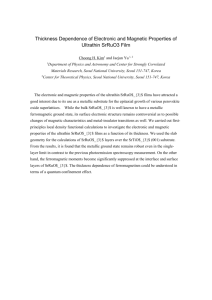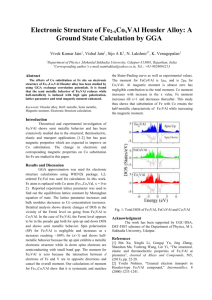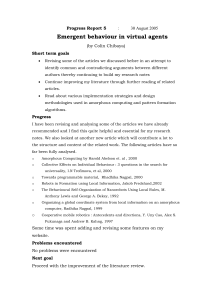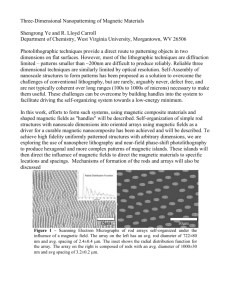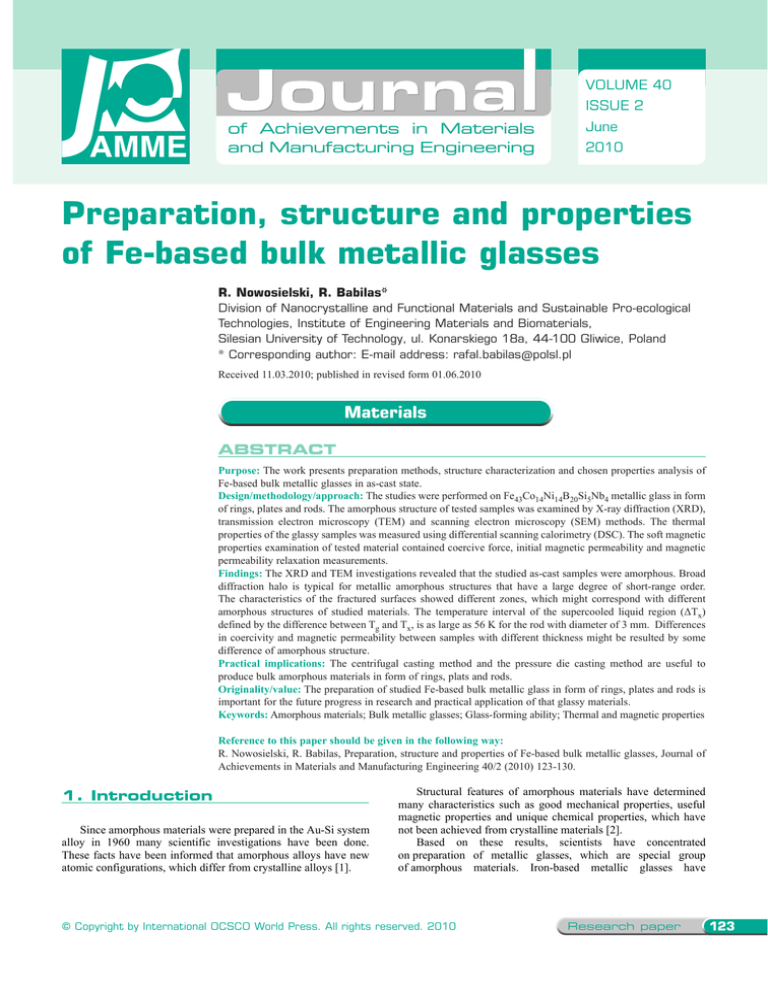
VOLUME 40
ISSUE 2
of Achievements in Materials
and Manufacturing Engineering
June
2010
Preparation, structure and properties
of Fe-based bulk metallic glasses
R. Nowosielski, R. Babilas*
Division of Nanocrystalline and Functional Materials and Sustainable Pro-ecological
Technologies, Institute of Engineering Materials and Biomaterials,
Silesian University of Technology, ul. Konarskiego 18a, 44-100 Gliwice, Poland
* Corresponding author: E-mail address: rafal.babilas@polsl.pl
Received 11.03.2010; published in revised form 01.06.2010
Materials
Abstract
Purpose: The work presents preparation methods, structure characterization and chosen properties analysis of
Fe-based bulk metallic glasses in as-cast state.
Design/methodology/approach: The studies were performed on Fe43Co14Ni14B20Si5Nb4 metallic glass in form
of rings, plates and rods. The amorphous structure of tested samples was examined by X-ray diffraction (XRD),
transmission electron microscopy (TEM) and scanning electron microscopy (SEM) methods. The thermal
properties of the glassy samples was measured using differential scanning calorimetry (DSC). The soft magnetic
properties examination of tested material contained coercive force, initial magnetic permeability and magnetic
permeability relaxation measurements.
Findings: The XRD and TEM investigations revealed that the studied as-cast samples were amorphous. Broad
diffraction halo is typical for metallic amorphous structures that have a large degree of short-range order.
The characteristics of the fractured surfaces showed different zones, which might correspond with different
amorphous structures of studied materials. The temperature interval of the supercooled liquid region (ΔTx)
defined by the difference between Tg and Tx, is as large as 56 K for the rod with diameter of 3 mm. Differences
in coercivity and magnetic permeability between samples with different thickness might be resulted by some
difference of amorphous structure.
Practical implications: The centrifugal casting method and the pressure die casting method are useful to
produce bulk amorphous materials in form of rings, plats and rods.
Originality/value: The preparation of studied Fe-based bulk metallic glass in form of rings, plates and rods is
important for the future progress in research and practical application of that glassy materials.
Keywords: Amorphous materials; Bulk metallic glasses; Glass-forming ability; Thermal and magnetic properties
Reference to this paper should be given in the following way:
R. Nowosielski, R. Babilas, Preparation, structure and properties of Fe-based bulk metallic glasses, Journal of
Achievements in Materials and Manufacturing Engineering 40/2 (2010) 123-130.
1.
Introduction
1. Introduction
Since amorphous materials were prepared in the Au-Si system
alloy in 1960 many scientific investigations have been done.
These facts have been informed that amorphous alloys have new
atomic configurations, which differ from crystalline alloys [1].
Structural features of amorphous materials have determined
many characteristics such as good mechanical properties, useful
magnetic properties and unique chemical properties, which have
not been achieved from crystalline materials [2].
Based on these results, scientists have concentrated
on preparation of metallic glasses, which are special group
of amorphous materials. Iron-based metallic glasses have
© Copyright by International OCSCO World Press. All rights reserved. 2010
Research paper
123
Journal of Achievements in Materials and Manufacturing Engineering
increased the scientific and engineering importance, because
of their good soft magnetic properties, such as low coercive force,
high magnetic induction and magnetic permeability [3].
It is important to known that preparation of conventional
glassy alloys requires high critical cooling rates of about 106 K/s
(Fig. 1). Critical cooling rate is necessary to determine a glassforming ability (GFA) and to produce metallic glasses [2].
Fig. 1. A comparison of critical cooling rate for conventional and
bulk metallic glasses [4]
Scientific investigations of rapid solidification and glassforming ability processes have succeeded in finding new
multicomponent metallic glasses with much lower critical cooling
rate. Inoue et al. succeeded in casting Fe-based bulk metallic
glasses in Fe-based alloy systems with low critical cooling rates
below 103 K/s [2,5].
Inoue at el. based on the multicomponents of glassy alloys
with high GFA have proposed empirical rules for achieving high
glass-forming ability, low critical cooling rate and maximum
amorphous sample thickness (Fig. 2). These rules have informed
that multicomponent alloy should consist of more than three
elements; the alloy should contain two or more metallic elements
with different atomic sizes; the metallic elements should have
large negative heats of mixing with the metalloid type
of components and the alloy should be eutectic [1,2,4].
Fig. 2. Schematic correlation between high glass-forming ability,
glass transition temperature, maximum sample thickness and
critical cooling rate of metallic glasses [1]
124
Research paper
Volume 40 Issue 2 June 2010
2.Material and research
2. Material
and research methodology
methodology
The aim of the paper is the characterization of preparation
methods, microstructure, thermal and magnetic properties analysis
of Fe-Co-Ni-B-Si-Nb bulk metallic glass in as-cast state.
Investigations were done with use of XRD, TEM, SEM, DSC and
magnetic measurements methods.
Mixture of pure elements with the nominal composition
of Fe43Co14Ni14B20Si5Nb4 were melted under argon atmosphere
to obtain homogeneous ingots. The pre-alloying of the
components of studied alloy was carried out by using the ingot
preparation equipment presented in Fig. 3. The alloy ingot was
prepared in ceramic (Al2O3) crucible, which was indirectly heated
by graphite crucible by induction coil.
Studied samples were manufactured by the pressure die
casting method (plates and rods) and the centrifugal casting
method (rings). The pressure die casting technique [6,7] is the
method of casting a molten alloy ingot into copper mould under
gas pressure. Fig. 4 shows photographic illustrations of the
pressure die casting method (including heating and casting stages)
used for the production of bulk amorphous plates or rods.
The centrifugal casting method has been used to fabricate
the samples of bulk metallic glass in form of rings. This casting
method is useful to produce bulk amorphous materials in form
of rings, tubes or amorphous matrix composites [8].
The investigated material was cast in form of the ring with
diameter of 30 mm and thickness of 0.5 mm, plate with thickness
(g) of 1 mm and rod with diameter (ø) of 3 mm (Fig. 5).
Structure analysis of the samples in as-cast state was carried
out using X-ray diffractometer (XRD) with CoKĮ radiation for
plate and rod samples examination. The data of diffraction lines
were recorded in 2ș range from 35° to 80°.
The fracture morphology of the samples in form of ring, plate
and rod was analyzed using the scanning electron microscopy
(SEM). Transmission electron microscopy (TEM) was used for
the structural characterization of samples in as-cast state. Thin
foils for TEM observation (from central part of tested samples)
were prepared by an electrolytic polishing method after previous
mechanical grinding.
Thermal properties associated with glass transition (Tg), onset
(Tx) and peak (Tp) crystallization temperatures and supercooled
liquid region (ǻTx) between Tg and Tx was examined
by differential scanning calorimetry (DSC). The heating rate
of calorimetry measurements, under an argon protective
atmosphere, was 20 K/min.
Magnetic measurements of studied samples in as-cast state,
carried at room temperature, included following properties:
(a) relative magnetic permeability (µr) - determined with
Maxwell-Wien bridge at a frequency of 1030 Hz and
magnetic field H = 0.5 A/m [9-11];
(b) magnetic permeability relaxation (ǻµ/µ) also defined as
“magnetic after-effects” - determined by measuring changes
of magnetic permeability as a function of time after
demagnetization, where ǻµ is difference between magnetic
permeability determined at t1 = 30 s and t2 = 1800 s after
demagnetization [12-14];
(c) coercive force (Hc) - measured by coercivemeter.
Adittionally, Hc and ǻµ/µ was determined for samples with
different form and thickness.
R. Nowosielski, R. Babilas
Materials
a)
b)
Fig. 3. Preparation of master alloy by induction melting: (a) photograph and (b) schematic illustration of ingot preparation equipment
Fig. 4. Chosen stages of the pressure die casting method used for bulk amorphous samples casting
a)
b)
c)
Fig. 5. Outer morphology of cast glassy Fe43Co14Ni14B20Si5Nb4 alloy samples in form of: a) rings, b) plates, c) rods
Preparation, structure and properties of Fe-based bulk metallic glasses
125
Journal of Achievements in Materials and Manufacturing Engineering
3.Results
and discussion
3. Results and discussion
The XRD investigations confirmed that the studied as-cast
glassy samples were amorphous. The diffraction patterns of tested
ring with diameter of 30 mm and thickness of 0.5 mm (Fig. 6a),
plate with thickness of 1 mm (Fig. 7a) and rod with diameter of
3 mm (Fig. 8a) show the broad diffraction halo with rounded top
a)
Volume 40 Issue 2 June 2010
centered at about 52. This effect is typical of metallic amorphous
structures that have a large degree of short-range order.
Figs. 6b, 7b and 8b present TEM images and electron
diffraction patterns of the selected samples in as-cast state.
The TEM images revealed only some changes in contrast,
which is characteristic for amorphous structure. The electron
diffraction patterns consisted only of the halo rings. Broad
diffraction halo can be seen for all examined samples.
b)
Fig. 6. X-ray diffraction pattern (a) and transmission electron micrograph and electron diffraction pattern (b) of Fe43Co14Ni14B20Si5Nb4
glassy ring in as-cast state with diameter of 30 mm and thickness of 0.5 mm
a)
b)
Fig. 7. X-ray diffraction pattern (a) and transmission electron micrograph and electron diffraction pattern (b) of Fe43Co14Ni14B20Si5Nb4
glassy plate in as-cast state with thickness of 1 mm
a)
b)
Fig. 8. X-ray diffraction pattern (a) and transmission electron micrograph and electron diffraction pattern (b) of Fe43Co14Ni14B20Si5Nb4
glassy rod in as-cast state with diameter of 3 mm
126
Research paper
R. Nowosielski, R. Babilas
Materials
These results indicated that tested samples are composed of
a single amorphous phase.
Figs.
9-11
show
the
DSC
traces
of
bulk
Fe43Co14Ni14B20Si5Nb4 alloy at a heating rate of 20 K/min under
a flow of argon. The examined alloy prepared in form of ring,
plate and rod exhibits the sequence of the glass transition
temperature (Tg), onset (Tx) and peak (Tp) crystallization
temperature.
The shapes of DSC curves for ring, plate and rod are very
similar. The exothermic peaks describing crystallization were
observed for all samples. The crystallization effect for the ring
sample with diameter of 30 mm and thickness of 0.5 mm includes
onset crystallization temperature Tx = 847 K and peak
crystallization temperature Tp = 866 K (Fig. 9).
Fig. 11. DSC curves of Fe43Co14Ni14B20Si5Nb4 glassy alloy rod
in as-cast state (heating rate 20 K/min)
Fig. 9. DSC curves of Fe43Co14Ni14B20Si5Nb4 glassy alloy ring
in as-cast state (heating rate 20 K/min)
In the case of the plate with thickness of 1 mm, the
exothermic effect includes onset of the crystallization temperature
at Tx = 849 K and peak crystallization temperature at Tp = 872 K
(Fig. 10). For the rod with diameter of 3 mm onset crystallization
temperature reached a value of 854 K and peak crystallization
temperature was 879 K, respectively (Fig. 11).
Fig. 10. DSC curves of Fe43Co14Ni14B20Si5Nb4 glassy alloy plate
in as-cast state (heating rate 20 K/min)
The DSC analysis allowed to determine glass transition
temperatures of examined glassy samples, which was 798 K for
ring, 800 K for plate and 802 K for rod, respectively.
Obtained results of DSC investigations confirmed that the
crystallization temperatures: (Tx), (Tp) and glass transition
temperature (Tg) increased with increasing of the sample
thickness. These results might be due to the changes in the
amorphous structure of tested glassy materials.
The temperature interval of the supercooled liquid region
(ǻTx) defined by the difference between Tg and Tx, is as large
as 56 K for the rod with diameter of 3 mm, which is very close
to 60 K reported by Inoue et al. [15].
The thermal properties parameters of studied glassy samples:
glass transition temperature (Tg), onset crystallization temperature
(Tx) and supercooled liquid region (ǻTx) are presented in Table 1.
Table 1.
Thermal properties of the studied Fe43Co14Ni14B20Si5Nb4 samples
in forms of ring, plate and rod, in as-cast state
Tx
ǻTx
Thickness
Tg
Sample
[K]
[K]
[K]
[mm]
ring
0.5
798
847
49
plate
1
800
849
49
rod
3
802
854
56
The fracture surface of the investigated samples in form
of ring, plate and rod was investigated by SEM at different
magnifications. Figs. 12, 13 and 14 present schematic illustration
of tested samples and SEM micrographs of selected areas
of examined glassy materials.
The characteristics of the fractured surfaces showed different
fracture zones. The fractures could be classified as mixed types
with indicated zones contain weakly formed “river” and “shell”
patterns (Zone I) and “smooth” areas (Zone II). The schematic
illustrations of studied samples also included indicated zones.
The fracture surface of two zones probably informed about
different amorphous structures of the tested glassy materials.
The coercive force (Hc) of tested metallic glass had a value
of 19 A/m for glassy ring with thickness of 0.5 mm. Hc for glassy
plate with thickness of 1 mm was 41 A/m. What is more,
Preparation, structure and properties of Fe-based bulk metallic glasses
127
Journal of Achievements in Materials and Manufacturing Engineering
the coercive force had a value of 78 A/m for rod with diameter
of 3 mm. Fig. 15 presents coercive force versus sample thickness
for studied alloy (included samples with different thickness).
Volume 40 Issue 2 June 2010
However, differences in coercivity between samples with
different thickness were observed. These increased values of
coercivity might suggest some difference of amorphous structure.
Fig. 12. Fracture morphology of Fe43Co14Ni14B20Si5Nb4 amorphous ring in as-cast state with diameter of 30 mm and thickness of 0.5 mm:
A – schematic illustration of sample, B – SEM micrograph, magn. 300x
Fig. 13. Fracture morphology of Fe43Co14Ni14B20Si5Nb4 amorphous plate in as-cast state with thickness of 1 mm: A – schematic
illustration of sample, B – SEM micrograph, magn. 300x
Fig. 14. Fracture morphology of Fe43Co14Ni14B20Si5Nb4 amorphous rod in as-cast state with diameter of 3 mm: A – schematic illustration
of sample, B – SEM micrograph, magn. 300x
128
Research paper
R. Nowosielski, R. Babilas
Materials
Table 2.
Magnetic properties of the studied Fe43Co14Ni14B20Si5Nb4 samples
in forms of ring, plate and rod, in as-cast state
Thickness
Hc
ǻµ/µ
Sample
µr
[A/m]
[mm]
[%]
ring
0.5
19
1006
3.8
plate
1
41
879
2.2
rod
3
78
147
2.2
4.Conclusions
4. Conclusions
Fig. 15. Coercive force of Fe43Co14Ni14B20Si5Nb4 alloy versus
sample thickness
The initial magnetic permeability (µr) was 1006 for ring with
thickness of 0.5 mm, µr = 879 for plate sample with thickness
of 1 mm. Moreover, the initial magnetic permeability of studied
ring had a lower value µr = 147.
The magnetic permeability relaxation of the tested alloy
in relation to sample thickness is shown in Fig. 16. Basing on the
literature [12-14], the intensity of ǻµ/µ is directly proportional
to the concentration of the defects in amorphous materials, i.e.
free volume concentration.
The investigations performed on the Fe43Co14Ni14B20Si5Nb4
bulk metallic glass in form of rings, plates and rods allowed
to formulate the following statements:
x the XRD and TEM investigations revealed that the studied
as-cast bulk glassy samples were amorphous,
x the SEM images showed that studied fractures of ring, plate and
rod in as-cast state indicated two structurally different zones,
x changes of crystallization temperature and glass transition
temperature versus the thickness of the glassy samples were
stated,
x the supercooled liquid region (ǻTx) defined by the difference
between Tg and Tx, is as large as 56 K for the rod with
diameter of 3 mm,
x the initial magnetic permeability decreased but the coercive
force increased with increasing sample thickness,
x the magnetic permeability relaxation, which is directly
proportional to the microvoids concentration in amorphous
structure decreased with increasing sample thickness,
x differences in coercivity and magnetic permeability between
samples with different thickness might be resulted by some
difference of amorphous structure.
Acknowledgements
Acknowledgements
The authors would like to thank Dr W. Gáuchowski
(Non-Ferrous Metals Institute, Gliwice), Dr T. Czeppe (Institute
of Metallurgy and Materials Science) and Dr Z. Stokáosa (Institute
of Materials Science, University of Silesia, Katowice) for
a cooperation and helpful comments.
References
References
Fig.
16.
Magnetic
permeability
relaxation
Fe43Co14Ni14B20Si5Nb4 alloy versus sample thickness
of
[1]
The magnetic permeability relaxation (ǻµ/µ), which was
determined for samples in form of ring, plate and rod had a value
of 3.8, 2.2 and 2.2 %, adequately. Finally, Table 2 summarises
information concerning magnetic properties of the studied alloy
in form of the ring, plate and rod in as-cast state.
The values of coercivity and magnetic permeability might
suggest some degree of magnetic inhomogeneity.
[2]
[3]
A. Inoue, K. Hashimoto, Amorphous and nanocrystalline
materials: preparation, properties and applications, Springer,
2001.
A. Inoue, A. Makino, T. Mizushima, Ferromagnetic bulk
glassy alloys, Journal of Magnetism and Magnetic Materials
215-216 (2000) 246-252.
R.B. Schwarz, T.D. Shen, U. Harms, T. Lillo, Soft
ferromagnetism in amorphous and nanocrystalline alloys,
Journal of Magnetism and Magnetic Materials 283 (2004)
223-230.
Preparation, structure and properties of Fe-based bulk metallic glasses
129
Journal of Achievements in Materials and Manufacturing Engineering
[4]
W.H. Wang, C. Dong, C.H. Shek, Bulk metallic glasses,
Materials Science and Engineering R 44 (2004) 45-89.
[5] A. Inoue, B. Shen, A. Takeuchi, Fabrication, properties and
applications of bulk glassy alloys in late transition metalbased systems, Materials Science and Engineering A 441
(2006) 18-25.
[6] R. Nowosielski, R. Babilas, Structure and magnetic
properties of Fe36Co36B19Si5Nb4 bulk metallic glasses,
Journal of Achievements in Materials and Manufacturing
Engineering 30/2 (2008) 135-140.
[7] R. Nowosielski, R. Babilas, Structure and properties of
selected Fe-based metallic glasses, Journal of Achievements
in Materials and Manufacturing Engineering 37/2 (2009)
332-339.
[8] R. Nowosielski, R. Babilas, Fabrication of bulk metallic
glasses by centrifugal casting method, Journal of
Achievements in Materials and Manufacturing Engineering
20 (2007) 487-490.
[9] D. Szewieczek, T. Raszka, Structure and magnetic
properties of Fe63.5Co10Cu1Nb3Si13.5B9 alloy, Journal of
Achievements in Materials and Manufacturing Engineering
19 (2006) 179-182.
[10] D. Szewieczek, T. Raszka, J. Olszewski, Optimisation the
magnetic properties of the (Fe1-xCox)73.5Cu1Nb3Si13.5B9
130
Research paper
[11]
[12]
[13]
[14]
[15]
Volume 40 Issue 2 June 2010
(x=10; 30; 40) alloys, Journal of Achievements in Materials
and Manufacturing Engineering 20 (2007) 31-36.
S. Lesz, D. Szewieczek, J.E. Frąckowiak, Structure and
magnetic properties of amorphous and nanocrystalline
Fe85.4Hf1.4B13.2 alloy, Journal of Achievements in Materials
and Manufacturing Engineering 19 (2006) 29-34.
P. KwapuliĔski, J. Rasek, Z. Stokáosa, G. Badura,
B. Kostrubiec, G. Haneczok, Magnetic and mechanical
properties in FeXSiB (X=Cu, Zr, Co) amorphous alloys,
Archives of Materials Science and Engineering 31/1 (2008)
25-28.
G. Badura, J. Rasek, Z. Stokáosa, P. KwapuliĔski,
G. Haneczok, J. Lelątko, L. Pająk, Soft magnetic properties
enhancement effect and crystallization processes in
Fe78-xNbxSi13B9 (x = 0, 2, 4) amorphous alloys, Journal of
Alloys and Compounds 436 (2007) 43-50.
P. KwapuliĔski, Z. Stokáosa, J. Rasek, G. Badura,
G. Haneczok, L. Pająk, L. Lelątko, Influence of alloying
additions and annealing time on magnetic properties in
amorphous alloys based on iron, Journal of Magnetism and
Magnetic Materials 320 (2008) 778-782.
A. Inoue, B.L. Shen, C.T. Chang, Fe- and Co-based bulk
glassy alloys with ultrahigh strength of over 4000 MPa,
Intermetallics 14 (2006) 936-944.
READING DIRECT: www.journalamme.org

